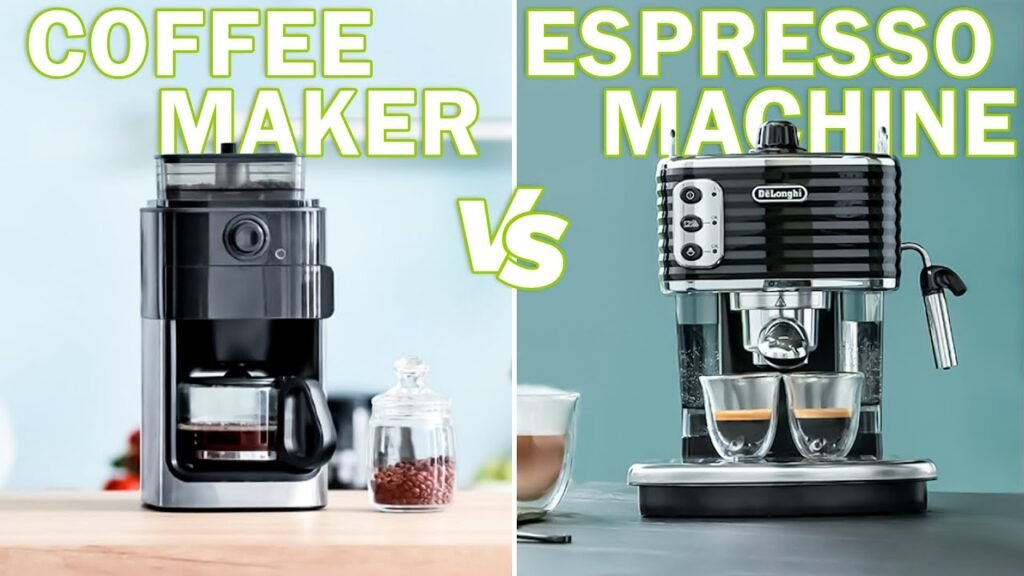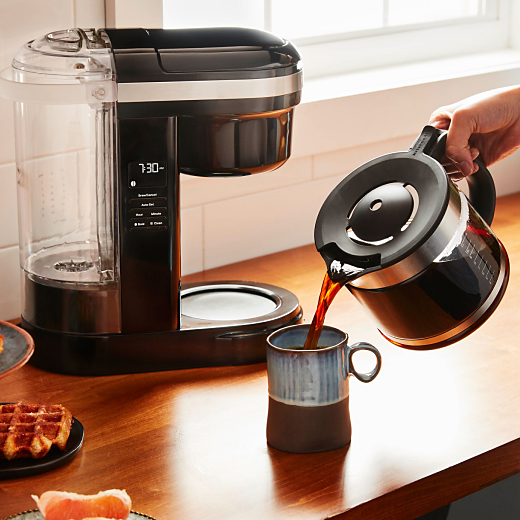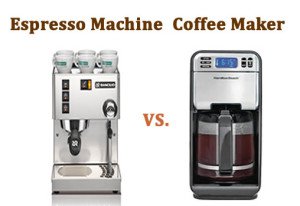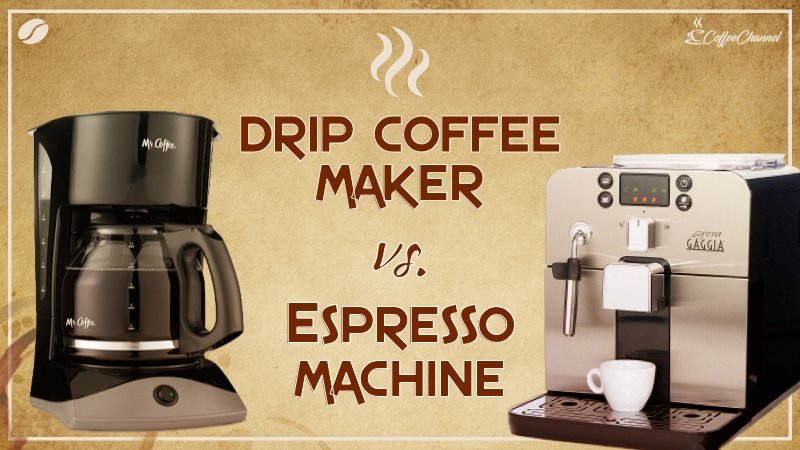Have you ever wondered about the secret behind that perfect cup of coffee? Well, wonder no more! In this article, we will explore the key distinctions between an espresso machine and a regular coffee maker. From the brewing process to the taste and intensity of the resulting beverage, we will highlight the unique features that set these two beloved coffee-making appliances apart. So, if you’re ready to uncover the mysteries of your morning brew, let’s get started!
Basic Function
Espresso Machine
An espresso machine is specifically designed to brew espresso, which is a concentrated and intense form of coffee. It uses a high-pressure system to force hot water through finely ground coffee to extract the rich flavors and aromas. Espresso machines are capable of producing a small amount of strong coffee in a short amount of time.
Regular Coffee Maker
On the other hand, a regular coffee maker, also known as a drip coffee maker, is designed to brew larger quantities of coffee. It works by pouring hot water over ground coffee, which then drips through a filter into a carafe. Regular coffee makers typically produce a milder cup of coffee compared to espresso machines.
Brewing Method
Espresso Machine
Espresso machines use a unique brewing method called extraction. This involves the process of water passing through coffee grounds under high pressure. The high-pressure system helps to extract the full flavor and concentration of the coffee, resulting in a rich and intense shot of espresso.
Regular Coffee Maker
In contrast, regular coffee makers use a simpler brewing method called drip brewing. Hot water drips over the coffee grounds, gradually extracting the flavors as it passes through. This method is less intense and produces a milder cup of coffee compared to espresso.

Pressure Requirement
Espresso Machine
Espresso machines require a significant amount of pressure to properly extract the flavors from the coffee grounds. The ideal pressure for brewing espresso is typically between 9 and 15 bars. This high-pressure environment ensures that the water is forced through the grounds, creating a strong and concentrated shot.
Regular Coffee Maker
Regular coffee makers do not require high pressure for brewing. They typically operate at atmospheric pressure, which is around 1 bar. This lower pressure allows for a slower extraction process, resulting in a milder coffee flavor.
Type of Coffee
Espresso Machine
Espresso machines are specifically designed to brew espresso, which requires a finer grind size and a specific type of coffee bean. Espresso beans are typically darker and more robust in flavor compared to regular coffee beans. The finer grind size allows for better extraction under high pressure.
Regular Coffee Maker
Regular coffee makers can brew a variety of coffee types, including drip coffee, pour-over, or even French press. This means you can use a wider range of coffee beans, from light to dark roasts, depending on your preferred flavor profile. The grind size for regular coffee is typically coarser than espresso.

Grind Size
Espresso Machine
To achieve the best results with an espresso machine, a fine grind size is essential. The finer grind allows for a larger surface area of the coffee particles, which facilitates better extraction. The ideal grind size for espresso is akin to table salt or slightly finer.
Regular Coffee Maker
Regular coffee makers require a coarser grind size compared to espresso machines. This is because the coffee grounds need to steep in hot water for a longer period during the brewing process. A medium-coarse grind, similar to the consistency of sand, is typically recommended for regular coffee makers.
Water Temperature
Espresso Machine
Water temperature plays a crucial role in brewing espresso. It is recommended to brew espresso within the range of 195 to 205 degrees Fahrenheit (90 to 96 degrees Celsius). This temperature range ensures that the water is hot enough to extract the flavors but not too hot to scorch the coffee.
Regular Coffee Maker
For regular coffee makers, the water temperature is generally recommended to be between 195 and 205 degrees Fahrenheit (90 to 96 degrees Celsius) as well. This range allows for optimal extraction while avoiding the risk of burning the coffee.

Brewing Time
Espresso Machine
Espresso is brewed quickly in an espresso machine, typically taking 25 to 30 seconds for a single shot. The high-pressure system allows for a rapid extraction process, resulting in a concentrated and intense shot of espresso.
Regular Coffee Maker
Regular coffee requires a longer brewing time compared to espresso. The brewing time for a regular coffee maker can vary depending on the quantity being brewed, but it typically ranges from 5 to 7 minutes. The slower extraction process allows for a more gradual and milder extraction of flavors.
Brewing Volume
Espresso Machine
Espresso machines are designed to brew small volumes of coffee at a time. They typically produce single or double shots of espresso, which are around 1 to 2 ounces (30 to 60 milliliters) in volume. This makes espresso machines ideal for individuals or small groups who prefer smaller and concentrated servings of coffee.
Regular Coffee Maker
Regular coffee makers are designed to brew larger volumes of coffee to cater to multiple servings. They typically have a carafe capacity ranging from 8 to 12 cups (64 to 96 ounces, or 1.9 to 2.8 liters). This makes regular coffee makers suitable for households or larger groups who prefer larger quantities of coffee.

Customization Options
Espresso Machine
Espresso machines offer a wide range of customization options to tailor the brewing process to your preferences. You can adjust the grind size, water temperature, and the amount of coffee used to achieve the desired taste and strength. Additionally, some espresso machines have features like milk frothers, allowing you to create various milk-based espresso beverages.
Regular Coffee Maker
While regular coffee makers may not offer as many customization options as espresso machines, they still provide some level of customization. You can adjust the amount of coffee used per brew and experiment with different coffee to water ratios to find your preferred taste. Some advanced models also offer adjustable brew strengths or programmable brewing options.
Cost
Espresso Machine
Espresso machines tend to be more expensive compared to regular coffee makers. The complexity of the machine, the high-pressure system, and additional features like milk frothers contribute to the higher cost. Prices for espresso machines can vary widely, ranging from affordable basic models to high-end professional-grade machines.
Regular Coffee Maker
Regular coffee makers are generally more affordable compared to espresso machines. Basic drip coffee makers can be found at relatively low prices, making them accessible to a wide range of budgets. Advanced models with additional features may cost more, but they still tend to be more budget-friendly compared to espresso machines.
In conclusion, espresso machines and regular coffee makers serve different purposes and cater to different preferences. Espresso machines are designed to brew concentrated and intense shots of espresso, using high pressure and specific brewing parameters. Regular coffee makers, on the other hand, are more versatile and can brew larger quantities of coffee with milder flavors. Consider your preferred coffee style, desired brewing volume, and customization options when deciding which type of machine is best suited for your needs.

